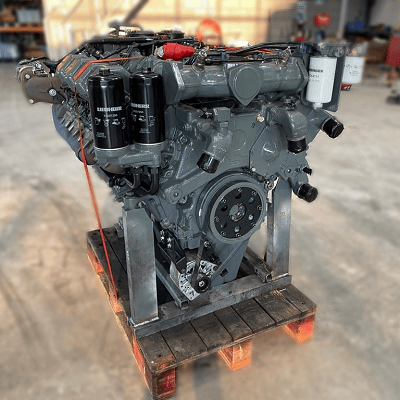The process of a dyno test on a Liebherr engine

When it comes to heavy machinery, reliability and power are paramount. Liebherr, a name synonymous with innovation and excellence in engineering, stands tall as a pioneer in the realm of heavy equipment and machinery. From towering cranes to robust excavators, Liebherr’s engineering prowess extends to the heart of these machines. We delve into the world of dyno testing a Liebherr engine, uncovering the meticulous process behind unleashing the raw power concealed within.
The foundation of excellence
Before we embark on the journey of dyno testing, it’s crucial to understand the foundation upon which Liebherr engines are built. With decades of engineering expertise and commitment to quality, Liebherr engines are crafted to withstand the most demanding environment and deliver unparalleled performance. Each component is meticulously designed and rigorously tested to ensure reliability, efficiency and longevity.
The process
1 Preparation: The engine undergoes meticulous preparation before being mounted onto the dynamo meter. This includes ensuring all connections are secure, fluids are filled to the appropriate levels, and sensors are properly calibrated.
2 Mounting: The engine is carefully mounted onto the dynamometer, a specialized device designed to simulate real-world operating conditions. Precision is paramount during this step to ensure accurate results.
3 Initial checks: Once mounted, a series of initial checks are conducted to verify proper alignment, connection integrity, and functionality of all engine systems.
4 Warm-up: The engine is started and allowed to warm up to operating temperature. This ensures consistent results and minimizes the risk of damage during testing.
5 Baseline testing: With the engine warmed up , baseline tests are conducted to establish initial performance metrics. This includes measuring power output, torque, fuel consumption, and emissions at various RPM levels.
6 Load testing: The engine is subjected to progressively increasing loads to simulate different operating conditions, such as idle, partial load and full load. This allows engineers to assess performance across the entire operating range and identify any potential issues or optimization.
7 Data analysis: Throughout the testing process, data is continuously collected and analyzed in real-time. Advanced instrumentation and software are used to monitor performance metrics and identify trends or anomalies.
8 Optimazation: Based on the data analysis, adjustments may be made to optimize engine performance. This could involve fine-tuning fuel injection timing, adjusting air-fuel ratios, or optimize turbocharger boost pressure.
9 Validation: Once testing is complete, the results are meticulously reviewed and validated against predetermined criteria and specifications. Any deviations or anomalies are thoroughly investigated to ensure accuracy and reliability.
10 Reporting: Finally, a comprehensive report is generated detailing the results of the dyno testing, including performance metrics, observations, and any recommendations for further optimization or refinement.
The outcome of dyno testing
Dyno testing a Liebherr engine is more than just a routine procedure – it’s a testament to the unwavering commitment to excellence that defines Liebherr’s engineering philosophy. By subjecting their engines to rigorous testing and analysis, Liebherr ensures that each engine delivers the uncompromising performance, reliability, and efficiency that customers expect.
In conclusion, dyno testing a Liebherr engine is not just about measuring power output. It’s about unlocking the true potential of these remarkable engines and ensuring they exceed expectations in the most challenging environments imaginable.
PVC High speed Auto-Recovery Door
Product Description
Recovery High Speed Door/ Self Recoverable Roller Shutter/Aoto Repair Roller Shutter Door
The advantage of Self Reparing High Speed Doors are self-reparing,easy to clean,complete safe,energy
saving and so on. If the door curtain comes out of its guides(for example in the event of impact with a forklift),
the system will reset the cutrain back intp the guide during the next opening cycle autimatically
Product Description
| PVC Curtain |
Grey,Yellow grid,Purple,Green,Light green,Black,Perforated Yellow grid,White,Blue,White grid,Sky Blue,Yellow,Orange,Red
Color curtain:0.8mmthickness. Function:insect prevention |
||||
| Door Size |
Max Door Size: 8M Wide x 6M Height |
||||
| Bottom Bar |
Aluminum alloy 95mm width Function:reinforce the crutain to keep the door opening without a hitch |
||||
| Radar Sensor |
The place on the cover box. Can detect 3 meters area! Function: detect the moving thing and open the door. For the place which has more people through. |
||||
| Photocell Sensor | Function:It's stop the door when the door is closing and someone through the door. | ||||
| Drive System |
High speed door motor: Germany brand(SEW)and Our own brand Hofic.
Germany SEW motor(380V/220V 50Hz 0.75KW,1.5KW,2.2kw.) |
||||
| Control System |
Control box:Include control system+PLC+transducer+encoder+airbag system. Brand:Japan Mitsubishi and Our own Hofic Function: all the control system are inside in it. |
||||
| Cover Box |
Material: Stainless steel201#or304# |
||||
| Running Speed |
Opening Speed:0.8m/s - 1.2m/s(Adjustable) Closing Speed:0.6m/s - 1.0m/s(Adjustable) |
||||
| Opening Way |
Radar sensor+push button for People through Magnetic loop+push button for forklift through |
||||
Main Accessories
Self-Repairing Door Curtain:
Made of reinforced PVC, with flexible weighted soft bottom edge.
The edge of curtain has continuous injection molded teeth that then move up and down in a self-lubricating
polyethylene track attached to structural galvanized side frames.
Auto Recovery Rapid Door,pvc machine protection high speed door,machine protection door,Recovery High Speed Door,Self Recoverable Roller Shutter,Aoto Repair Roller Shutter Door
SHENZHEN HONGFA AUTOMATIC DOOR CO., LTD , http://www.hongfahsrs.com